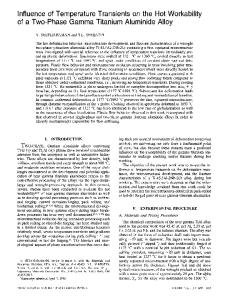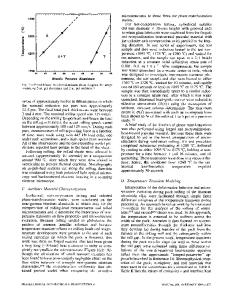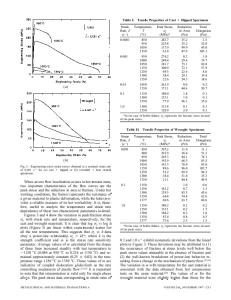Influence of microstructure on intrinsic and extrinsic toughening in an alpha-two titanium aluminide alloy
- PDF / 3,571,110 Bytes
- 17 Pages / 613 x 788.28 pts Page_size
- 91 Downloads / 277 Views
I.
INTRODUCTION
THE fracture mechanisms in two-phase (a= + fl)Ti3Al-based alloys have been studied in a number of recent investigations. [~-71 These investigations have revealed that the formation and linkage of microcracks ahead of the main crack are important features of the fracture process in a2 titanium aluminide a l l o y s . [3-6] For the Ti-24Al-11Nb alloy with an equiaxed a2 + / 3 microstructure, the microcracks have been observed to initiate at az/fl interfaces, [3"61 along planar slipbands in the otz phase, t4,61 and possibly at small az precipitates located within the disordered /3 phase. [61 Once nucleated, the microcracks are frequently arrested by the ductile/3 phase. Linkage of the microcracks with the main crack then requires fracturing the ductile/3 phase as well as any intact a2 phase in the unbroken ligaments separating the main crack and the microcracks. [6'8[ These ligaments, which are formed as the result of mismatched planes of microcracks, generally failed by shear, whose process might involve plastic dissipation, frictional work, or both.t891 The toughening mechanisms in Ti-24Al-11Nb include crack-tip blunting, crack deflection, and crack bridging, all of which are contributed at least partly, if not totally, by the ductile disordered body-centered cubic (bcc) /3 phase, t6,7[ The presence of shear ligaments in the process zone can lead to additional toughening effects, as shear fracture of those ligaments might require energy dissipation that far exceeds that required for matrix cracking. [81 These fracture and toughening characteristics observed in the Ti-24Al-llNb alloy, which are typical of alpha-two titanium aluminide alloys, signify that frac-
K.S. CHAN, Principal Engineer, is with the Materials and Mechanics Department, Southwest Research Institute, San Antonio, TX 782280510. Manuscript submitted February 28, 1991. METALLURGICAL TRANSACTIONS A
ture toughness in this alloy originates from both intrinsic and extrinsic means, t91 Intrinsic mechanisms, which include crack-tip blunting by a ductile phase, are expected to influence the initiation toughness (i.e., Ktc) values. In contrast, extrinsic mechanisms, which include microcrack shielding,[~~ crack deflection, [~1] and crack bridging by a ductile phase, [12,13,~41 or shear ligaments tsl are expected to affect the crack growth toughness and lead to a resistance curve behavior. In some cases, microcrack shielding and crack deflection can also lead to increases in the initiation toughness (K~c) value, depending on whether or not a deflected crack tip and shielding microcracks exist prior to crack growth. Most of the current models of ductile-phase toughening have considered toughening to arise mainly from bridging of the crack surfaces by unbroken plastic ligaments located behind the crack tip. Extrinsic in nature, this type of ductile-phase toughening affects mostly the crack growth toughness by inducing a resistance curve behavior through the formation of a bridged zone in the crack wake. t~2.~3[ For fracture of ductile-phase-toug
Data Loading...











